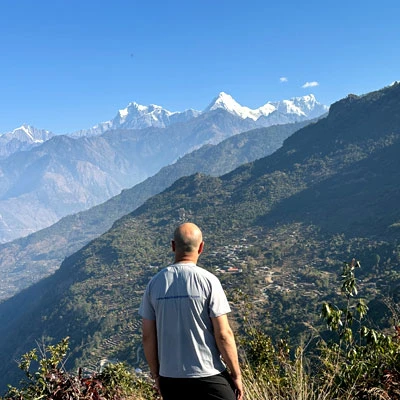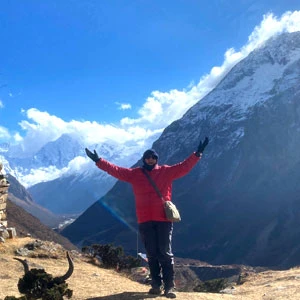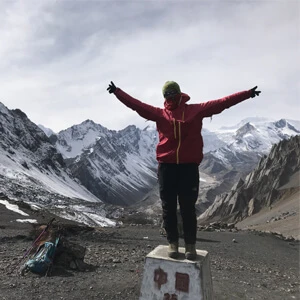Are you a thrill-seeker by nature looking for new horizons to explore, someone willing to travel to the most exotic destinations in the world in search of adventure? If so, then Nepal must be on top of your bucket list of countries to visit thanks to the spectacular range of wonders it has to offer, from the multi-faceted delights of its cultural heritage, the classic stupas and Buddhist monasteries hidden away behind its mountain barriers, rare animal species as the snow leopard and Bengal tiger, right on through to the geographic feature that most readily comes to mind when people think of Nepal — the Himalayas. And the mountain that immediately springs to mind when thinking of that formidable range? Everest of course, the peak that has become the stuff of legend to mountaineers and the general public alike.
Everest Base Camp Trekking Information
All you need to know before heading to the Everest Base CampEverest Base Camp Trekking Information

Trip Fact
- Maximum Height: 5550m
- Trip Style: Trekking/hiking
- Trip Grade: Strenuous
- Accommodation: Tea House
- The Best Time: March to May and September to November
- Duration of trek: 15 to 20 days depending on the trekking route
Everest Base Camp Trekking Itinerary
Day 01: Welcome at Tribhuvan International Airport and transfer to your Hotel
Day 02: Free day for preparation and sightseeing
Day 03: Kathmandu to Lukla by scenic mountain flight, then trek to Phakding (2610m, 4/5 hrs)
Day 04: Phakding to Namche Bazaar (3440m, 6 hrs)
Day 05: Acclimatization day in Namche
Day 06: Namche to Tengboche (3870m, 5/6 hrs)
Day 07: Tengboche to Dingboche (4410m, 6 hrs)
Day 08: Acclimatization day
Day 09: Dingboche to Lobuche (4940m, 6 hrs)
Day 10: Lobuche to Gorak Shep, on to Everest Base Camp, then back to Gorak Shep (5140m, 7 hrs)
Day 11: Early morning hike to Kala Patthar then descend to Pheriche (4280m, 6/7 hrs)
Day 12: Pheriche to Namche (3440m, 7 hrs)
Day 13: Namche to Lukla (2840m, 7 hrs)
Day 14: Lukla to Kathmandu by flight (35 minutes)
Day 15: Farewell
Additionally, you can go through our Everest base Camp Trek Home Page.
Best Season for Everest Base Camp Trek:
The best optimal trekking seasons for Everest Base Camp are March through May and September through November. However, to avoid the crowds & enjoy the peace you can still trek in the low season too.
How to Reach Everest Base Camp?
Given its stature in the trekking community, the hike to Everest Base Camp is one of the most popular in all of Nepal, with numerous starting points on offer including Lukla, Salleri, and Phaplu, the latter being the one that most closely resembles the traditional method from days gone by of trekking to Everest from Kathmandu to gain proper acclimatization for the summit. For those who need to keep the duration of a trek to a minimum flying into Lukla is the preferred option, though for those with the extra time the Phaplu and Salleri alternates offer a wider scope to appreciate the local Sherpa culture and the range of picturesque landscapes.
If you have a time restriction, first time in Nepal, confusing about fitness and high altitude, traveling on a budget, prefer to avoid the classic route, and still prefer to explore the close-up view of the tallest iconic peak in the world Mt. Everest then the newly opened and less explored 10 Days Pikey Peak Trek might be the best satisfactory.
Kathmandu to Lukla:

Lukla, situated at a height of 2840 meters, is the modern gateway to Everest for climbers and trekkers. A short flight away from Kathmandu, its popularity as the de facto access point to the Everest region makes it a prerequisite to book early morning flights as far in advance as possible, as adverse weather can disrupt later flights to an airstrip requiring optimal conditions to operate from. On that basis, even with the early morning flights, Nepal Trekking Experts generally recommends that our clients allow for some flexibility with their overall schedule.
While the Everest region is designated as an open trekking area where people can hike on their own, we suggest that the challenges of the route and the high altitude would be far better dealt with via the services of an appropriate guide and porter. Their presence adds considerably to the enjoyment and value of the trek and relieves visitors of loads and concerns that might hamper or even preclude reaching Everest.
Namche Bazaar:

Namche Bazaar, situated at a height of 3450 meters, is the de facto capital of the Sherpa people of the Sagarmatha/Khumbu region of Nepal and has a long and storied history as the major intersect for old trading routes to Renjo La and Nugpa La, as well as the trail to Everest. The largest town in the region and the major market for the people of the area, it's a colorful place that's popular with the trekking community and offers all the modern conveniences that they would expect. As the town is at over 3000 meters in altitude Nepal Trekking Experts recommends a one-day stay to help facilitate the all-important need to let the body acclimate to the rarified atmosphere. Namche is the perfect area to do so with numerous excursions within the vicinity to help pass the time, including places such as Everest View Hotel, Khumjung Valley, and the ancient monastery at Thame. Namche itself also has its attractions, not least its famous weekend market.
Recommended Treks in the Everest Region:
- Short Everest Base Camp Trek
- Everest Base Camp trek
- Everest Base Camp via Phaplu
- Everest Three High Passes trek
- Gokyo via Everest Base Camp Trek
- Gokyo Valley Trek
- Everest View Trek
- Pikey Peak Trek
- Everest Heli Tour
- Everest Base Camp Luxury Trek
Other Useful Information:
Acclimatization:
Regardless of your levels of fitness or previous experience each trip to high altitude requires a period of acclimatization to allow the body to grow accustomed to the reduced oxygen levels — it's essential to a successful outcome for every trek that ventures over the critical height of 3000 meters. Nepal Trekking Experts strictly adhere to appropriate procedures regarding periods of acclimation relevant to specific height gains, and inexperienced trekkers should be wary of any agencies that shortcut the process to try to maximize profits over the safety of clients. Other than the basic step of simply resting for a day to help the body adapt we also suggest using the 'trek higher, rest lower' philosophy of taking a short hike at the end of each day to a higher altitude than your rest stop for the evening, a strategy that helps people to sleep a little easier during the night.
What is Acute Mountain Sickness (AMS)?
Acute Mountain Sickness is the effect of decreased oxygen levels at high altitudes on the body when it hasn't had sufficient time to adapt. Other aspects such as dehydration can also be a contributing factor, which is why our guides always try and ensure that our clients drink an appropriate amount of water each day, as well as abstain from alcohol. Typical symptoms include persistent headache, fever, loss of appetite, fatigue, nausea, inability to sleep, vomiting, diarrhea, and dizziness.
How to prevent AMS?
There are many ways to prevent AMS such as —
- Hike higher, sleep lower
- Slow and steady progress while hiking
- Maintain eating habits and drink sufficient amounts of water
- Abstain from alcohol and smoking
- Observe proper acclimatization procedures
- Proper trekking gear and dress up
- Listening to the guidance of your trained guides
What should I do if I get altitude sickness?
- Take a rest and make sure you are drinking sufficient quantities of water or hot soup
- Maintain body warmth
- Take appropriate medications such as Paracetamol or Diamox
- Descend to lower altitudes until the symptoms recede
- If all else fails and you can't manage to get to a lower altitude under your own steam the quick and easy solution might be to use mule transportation or, if circumstances permit, then use helicopter evacuation.
How do I arrange domestic travel?
Trekkers can contact the trekking agency or manage on their own. If you prefer traveling by road from Kathmandu to Shivalaya then you can obtain a local bus ticket at Ratna Park. Or you can drive from Chabahil to Salleri by public Jeep. Flight can be arranged by an agency or yourself which is entirely up to you.
How far in advance should I book a flight to Lukla?
Particularly during the peak season, it's recommended to book early morning tickets to Lukla at least a couple of months in advance. Morning is by far the best option for flying in and out of Lukla because weather conditions later in the day frequently interfere with operations.
What type of permits is necessary to trek to Everest Base camp? Where are they obtained? How long does it take to obtain the permits and what are the costs? What documents do I need? How long are the permits valid?
For details information please kindly visit our Nepal trekking Permits and Fees blog.
Do I need any specialized training to trek to Everest Base Camp?
No, though some prior trekking experience is certainly of benefit to handle the challenges you'll come up against, not least the altitude.
What are the fitness requirements for the trek?
Being supremely fit for such an endeavor is not a prerequisite, though we do strongly suggest that you set aside at least a few months before your trek to undertake a basic fitness regimen — the fitter you are, the easier you'll be able to handle the more physically demanding stretches.
What is the age limit for trekking to Everest Base Camp?
There are no age limits for trekking to the base camp, though common sense factors in regarding how old your children should be to undertake such a long and physically demanding journey.
Can I store my unnecessary gear in Kathmandu?
Yes, you can store your gear either with your agency or by arrangement with your hotel.
Do I need a guide and Porter?
Guides and porters are not mandatory for trekking in the Everest region. However, we can't urge their use highly enough as their services can make all the difference on a challenging route where every extra ounce you're carrying starts to feel like a pound of dead weight as you progress over rough terrain and at high altitudes. Apart from the additional and cheery companionship they provide they're also very familiar with the region and can provide insights into local culture, religion, language wildlife, and scenery that add an entirely different dimension to your experiences.
Do I need insurance?
Yes, high altitude coverage is essential, and it's also recommended that you pay close attention to the details to ensure that trekking is covered by the policy, as well as hospitalization and medical evacuation.
Can I buy or rent trekking gear in Kathmandu?
Everything and anything you might need is available, either through name-brand stores or the many stores that offer locally-made products.
What kind of water should I drink?
While some trekkers take their chances with mountain water and get by without any ill effects, it's recommended to either drink bottled water en route or take appropriate sterilization equipment on your journey, either in the form of basic tablets or through ultraviolet devices such as Steripens.
Do I need a sleeping bag for the trek?
We recommend -20-degree sleeping bags to handle all the conditions you might come across during the trek.
Can I get electricity during the trek to keep the batteries charged?
Electricity is available, though at a fee. The typical costs range from 300 to 500 rupees for a full charge.
What currency should I take along during the trek?
Nepalese rupees are the currency of choice. Foreign currencies should be reserved for use in major towns and cities.
Are ATMs available during the trek??
You might find an ATM in Namche Bazaar but other than that you should be prepared to take as much cash as necessary for the entire trek. Also, don't rely too much on the ATM at Namche - it's not possible for it to break down, which could leave you in a bind.
What kind of trekking gear do I need?
For a detailed list go through this link — Trekking Gear
You may also read our full informative and refreshing latest Blog below:
20 Top-Ranked Trekking in Nepal
The Best Season to go to Nepal
Trekking in Nepal after Coronavirus
The 10 Best Shorts Treks in Nepal
Top Ten Reasons to hike Manaslu Circuit Trek
About Everest Region Trekking Routes
Nepal Trekking Permits and Fees Cost







